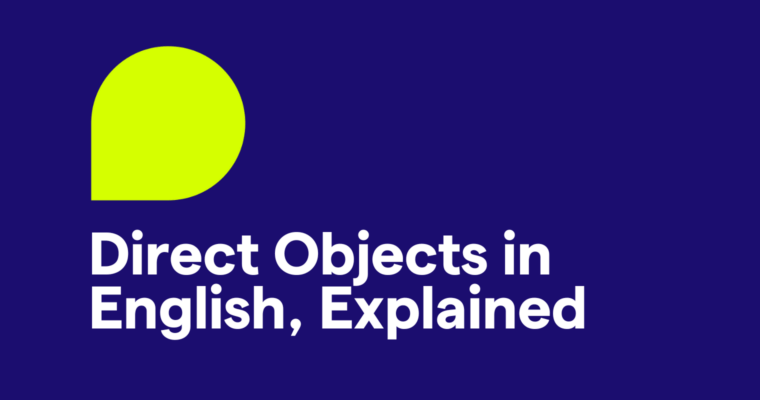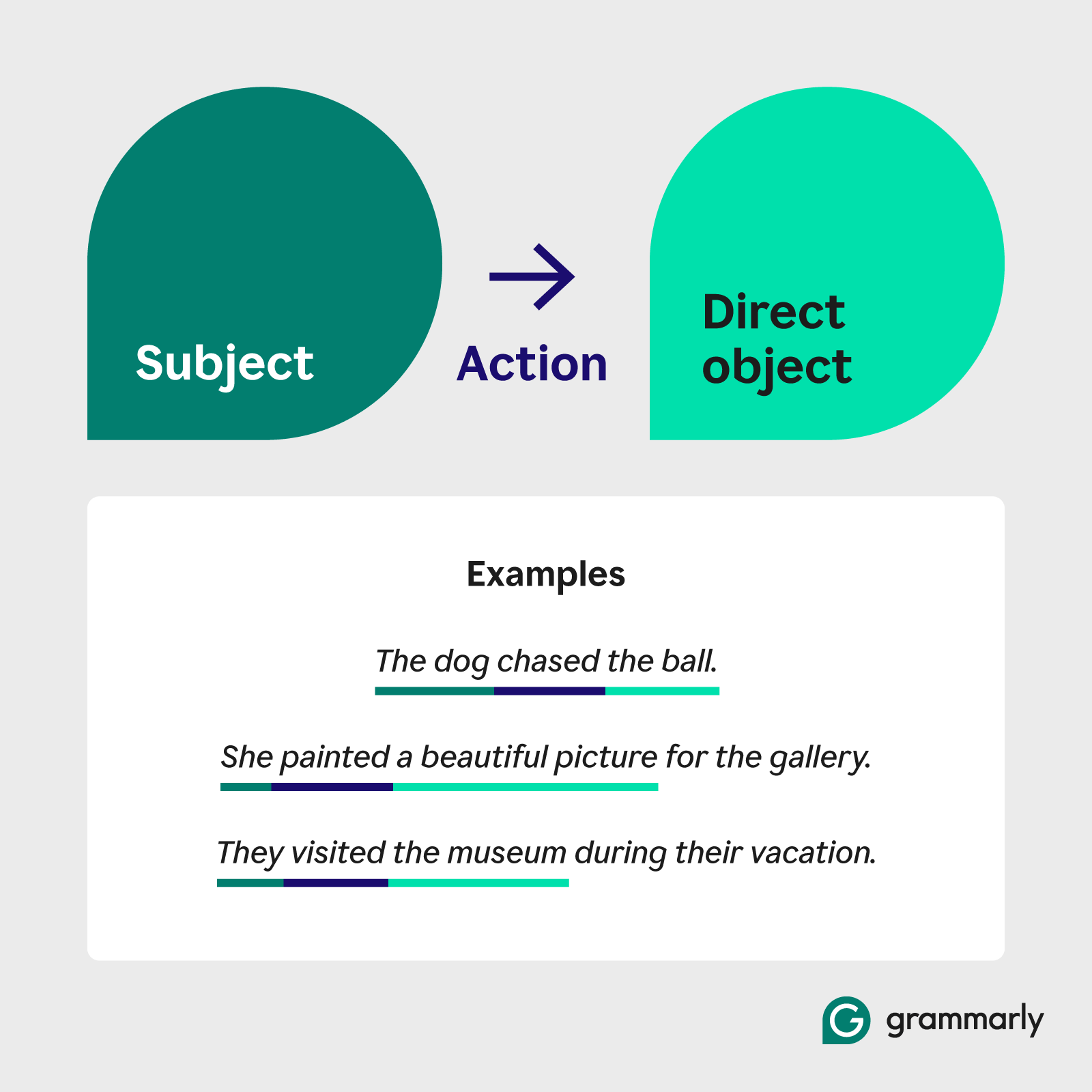
Key takeaways:
- A direct object is a noun that receives the verb’s action and answers the questions “what?” or “whom?” in a sentence.
- Direct objects can be single words, phrases, or clauses. They often follow transitive verbs, which require an object.
- Direct objects differ from indirect objects, which answer the questions “to whom?” or “for whom?” and are optional in sentences.
In English grammar, a direct object is a word or phrase that receives the verb’s action. In the sentence “The students eat cake,” the direct object is cake because it is what is being eaten by the students, which is the subject; meanwhile, eat is the verb.
Direct objects can be tricky, especially when paired with indirect objects. This guide will break down everything you need to know about using them correctly, explain the difference between indirect and direct objects, and provide examples to help clarify.
Table of contents
Direct objects as phrases and clauses
Direct objects vs. indirect objects
Direct objects and linking verbs
Using direct objects with verbs
What is a direct object?
A direct object is a noun that receives the action of the verb. Don’t confuse the direct object with the subject—the noun that acts—or the verb itself.
Direct objects usually answer the question “what?” or “whom?” Let’s take another look at the direct object example mentioned earlier.
Direct Object Sentence Examples
You can better understand how direct objects function in a sentence by identifying the subject, verb, and direct object separately:
| Sentence | Subject (who is acting) | Verb (what action is being performed) | Direct object (what is being acted upon) |
| The students eat cake. | the students | eat | cake |
| The family hugged their dog. | the family | hugged | their dog |
Direct object examples
Let’s look at some direct object examples to see how they work. The direct objects are underlined, and the subjects are in bold.
- The chef prepared a delicious meal for the guests.
- She painted a beautiful picture for the gallery.
- The dog chased the ball.
- He fixed the car in the garage.
- They visited the museum during their vacation.
Below are a few more examples illustrating direct objects in sentence structure.
Direct objects as phrases and clauses
Direct objects aren’t always just one word; sometimes, they are entire phrases or clauses. These phrases always act collectively as nouns. Aside from standard noun phrases, direct objects are often relative clauses (clauses that begin with a relative pronoun like what) or gerund phrases (noun phrases that start with gerunds). Here are a few examples:
- The foul ball hit a car parked outside.
- Don’t forget what your mother said.
- English professors love naming every tiny word in a sentence.
You can sometimes use the infinitive form of a verb as a direct object, but be careful not to confuse the to in an infinitive with the to in a prepositional phrase.
- Everyone wants to eat later.
- Everyone wants to watch the sunset.
- She prefers to read before bed.
Direct object pronouns
English uses two different pronouns to refer to the same person, depending on whether the pronoun is used as a subject or an object. For example, if you were talking about yourself as the subject of a sentence, you would use “I,” but if you were talking about yourself as the object, you would use “me.”
With direct objects, always use the object pronoun. If you’re unfamiliar with the differences, you can review subject and object pronouns here, but here’s a quick chart as a reminder:
| Subject pronoun | Object pronoun |
| I | me |
| you | you |
| he/she/they/it | him/her/them/it |
| we | us |
| you (plural) | you (plural) |
| they | them |
Direct objects vs. indirect objects
One of the most confusing topics in English is understanding the difference between direct objects and indirect objects. While direct objects answer the questions “what?” or “whom?” about the action of the verb, indirect objects answer questions like “to whom?” or “for what?” Take this example:
In the sentence, loaned is the verb, and my brother is the subject (because he’s doing the loaning). The direct object is $5 because it answers the question “What is being loaned?” The indirect object is me because it answers the question “To whom is the $5 being loaned?”
Direct objects and linking verbs
One last rule about direct objects involves linking verbs like be, seem, and feel. Linking verbs seem to use direct objects, but the word following the linking verb is called a complement, which is slightly different. A complement is often an adjective, but when it’s a noun, it can easily be confused with a direct object.
In this example, experts may seem like a direct object, but it’s a complement because it provides more information about the subject, they. The verb, a conjugation of be, is a linking verb, not a transitive verb.
Using direct objects with verbs
Direct objects are crucial in sentence structure, but not all verbs require them. Some verbs function with direct objects (transitive verbs), while others do not (intransitive verbs). Understanding the difference helps you form grammatically correct sentences.
Transitive verbs
Verbs that take a direct object are called transitive verbs. These verbs require something or someone to receive the action. For example:
- She wrote a letter. (Letter is the direct object receiving the action of writing.)
- They built a house. (A house is the direct object receiving the action of building.)
Without a direct object, these sentences would feel incomplete.
Intransitive verbs
Unlike transitive verbs, intransitive verbs don’t use a direct object. Verbs like laugh and sit can’t take direct objects because it wouldn’t make sense—you can’t laugh something or sit someone. Intransitive verbs are often followed by a prepositional phrase or an adverbial phrase that links the action to the direct object.
A prepositional phrase begins with a preposition and includes an object, often explaining direction, location, or cause. An adverbial phrase modifies the verb by describing when, where, or how an action occurs.
The tables below illustrate how these phrases function in sentences with intransitive verbs.
Prepositional Phrases
| Sentence | Verb | Prepositional phrase | Transitive or intransitive? |
| We all laugh at Anania Williams. | laugh | at Anania Williams | Laugh does not take a direct object. The prepositional phrase at Anania Williams modifies laugh, making it intransitive. |
| We drove to the mall. | drove | to the mall | Drove is intransitive here, as it does not take a direct object. To the mall is a prepositional phrase that shows direction, but the verb itself remains intransitive. |
Adverbial Phrases
| Sentence | Verb | Adverbial phrase | Transitive or intransitive? |
| The band played last night. | played | last night | Played does not take a direct object. The adverbial phrase last night modifies played by telling us when, making it intransitive. |
| She played drums in a heavy metal band. | played | in a heavy metal band | Played is transitive here because it takes a direct object (drums). In a heavy metal band is an adverbial phrase modifying the verb. |
If you’re unsure whether a verb is transitive or intransitive, checking a dictionary can help clarify its usage.
Strengthen your sentence structure
Using direct objects correctly can make your writing clearer and more precise. Indirect objects add depth by indicating to whom or for whom an action is performed. Together, these elements create a balanced and engaging writing style.
Polish your writing with Grammarly
Grammarly goes beyond basic spell-checking, helping you identify sentence structure issues and providing suggestions that elevate both the grammatical accuracy and stylistic quality of your writing.
Whether refining your grammar or strengthening your sentence flow, Grammarly’s real-time suggestions make the writing process effortless.
Direct objects FAQs
Understanding direct objects is key to crafting clear and precise sentence structure. Below are frequently asked questions about their role in sentences and how to identify them.
How do I find the direct object in a sentence?
To find the direct object, locate the verb and ask what or whom it affects. The answer is the direct object, which receives the action of the verb. For example, in “He read the book,” read is the verb. Asking “read what?” shows that the book is the direct object.
Direct objects appear only with transitive verbs—verbs that require an object to complete their meaning. Not all sentences have direct objects; some verbs don’t need one.
What is the difference between direct and indirect objects?
A direct object directly receives the verb’s action and answers “what?” or “whom?” For instance, in “The chef prepared the meal,” the meal is the direct object.
An indirect object indicates to whom or for whom the action is done, answering “to whom?” or “for whom?” For example, in “The chef served us the meal,” us is the indirect object (who received it), while the meal remains the direct object (what was served).
What are some examples of the direct object?
Below are a few examples of the direct object:
- He kicked the ball.
- They painted the wall.
- She wrote a letter.
- I found the keys.
- We enjoyed the concert.
In each case, the direct object answers “what?” or “whom?” after the verb.






